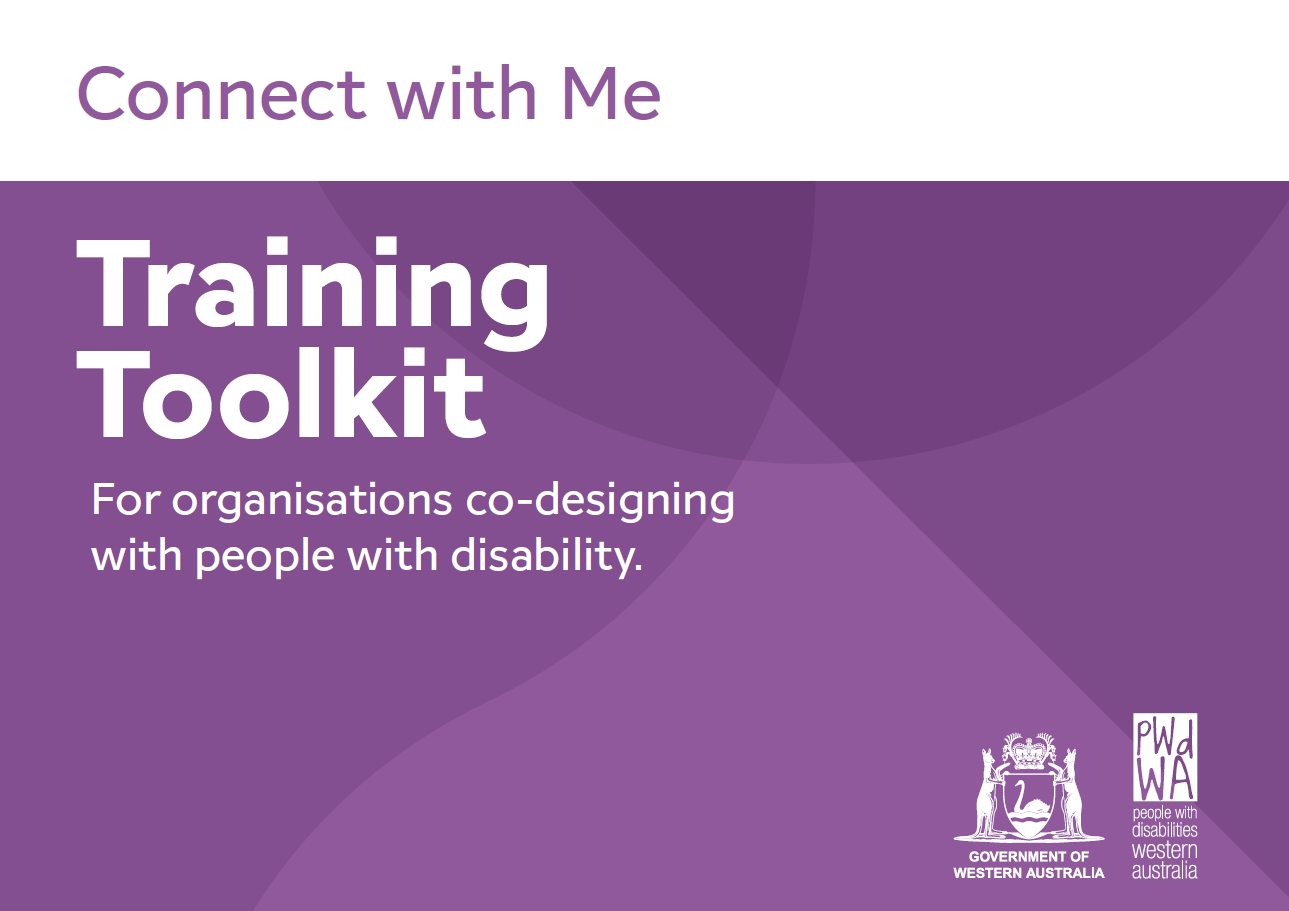
Introduction
About Co-design
Co-Design is a way of improving services with people with disability.
Co-design focuses on understanding and improving peoples experiences of services as well as the services themselves.
This is the web version of the Co-Design Toolkit. Please use the below buttons to download the Toolkit in PDF and Text-only versions.
DOWNLOAD PDF DOWNLOAD TEXT ONLY VERSION
What this toolkit provides
This toolkit will provide you with directions on how to successfully engage, connect and co-design with people with disability.
Should you have a specific enquiry or require specific training, please contact us at [email protected].
Table of Contents
Engage
Plan
- About Plan
- Route Maps
- Route Map Example: Develop
- Route Map Example: Improve
- Route Map Example: Solve
Explore
- About Explore
- Journey Mapping
- Process of Journey Mapping
- Journey Mapping Path
- Assumption Busting
- Exercise: Assumption Busting
Develop
Decide
Change
- About Change
- The Biggest Difference Tool
- The Biggest Difference Template
- Service Blueprints
- Example: using an Expression of Interest (EOI) process
Co-Design Principles
Appendix
Engage
About Engage
Establishing and maintaining meaningful relationships with people with disability to understand and improve services. This critical element underpins all improvement work and is continuous throughout.
Example: Connect With Me Project Steering Committee
- Talk with prospective members
- Build relationships through an ice-breaker activity
- Provide information and gather feedback
- Use benchmarking surveys when the project begins
- Research on similar issues
- Practical insights from similar projects
- Pilot ideas and refine them together
Plan
About Plan
Working with people with disability and organisational management to establish the goals of your improvement work and how you might go about achieving them.
Route Maps
Route maps are used to demonstrate how to proceed with a particular activity.
- They can be used with organisations who know what they need to do and want to engage with stakeholders but don’t know where to start
- They can be used to estimate the timeframes and resources required
Route Map Example: Develop
Example A: Route map to Develop a new service
- Start-up meeting
- Planning workshop
- Journey Mapping
- Stakeholder needs comparison
- Prototyping
- Service blueprint
Route Map Example: Improve
Example B: Route map to Improve an existing service
- Start-up meeting
- Planning workshop
- Journey Mapping
- Shadowing or lived experience stories
- Ideas groups
- The biggest difference
Route Map Example: Solve
Example C: Route map to Solve a specific issue
- Start-up meeting
- Planning workshop
- Shadowing
- Journey Mapping
- Prototyping
Explore
About Explore
Learning about and understanding the experience of people with disability in using services and identifying improvement ideas.
Journey Mapping
A journey map is a diagram of a person’s service experiences. Identifying, mapping and planning the service experience can identify ways to improve.
Information is recorded in a way that suits the situation - could include audio or video. All approaches rely on note-taking by or on behalf of people, which needs to be managed carefully.
Two main methods are individual interviews or working with groups of similar people or who have similar service experiences
Process of Journey Mapping
- Start your interview or workshop from the perspective of the person, the families and other supporters (noting families and supporters have significant journeys). Draw out stories from beginning to end.
- Divide stories into phases to understand how the journey changes. Three to five phases is usually good.
- Write down the phases on a large sheet of butcher paper. This is known as a journey sheet.
- Ask people to describe their overall experience of each phase in more detail.
- You could use a scale from one to ten to rate feelings and write it on the sheet. Record feelings at each phase.
- Ask people to highlight any especially good and bad service experiences in each phase. Summarise the experience on the journey sheet. Record any details about specific service elements on a separate sheet.
- Thank the people on their ‘map’ and on the insights and opportunities it affords.
- Develop a master version by including all the different versions you have. If people want to keep maps, you could take a photo to make sure you have an accurate record.
- Add any observations of your own, asking for comments.
- Ask for feedback on the map.
Please keep in mind that:
- The first draft includes everything and will be messy and complex. Keep simplifying it until key improvements are clear in each phase drawn from peoples experiences. Include the person in the refining process if you can.
- Next, find the phases and actions in the journey where you/your organisation is responsible and highlight any critical improvements that are required. Make sure you clearly understand each phase.
- The final diagram and accompanying detailed notes can become a central reference for improvement teams and future work. It is important to make sure it is accurate, emotionally rich and visually simple.
Journey Mapping Path
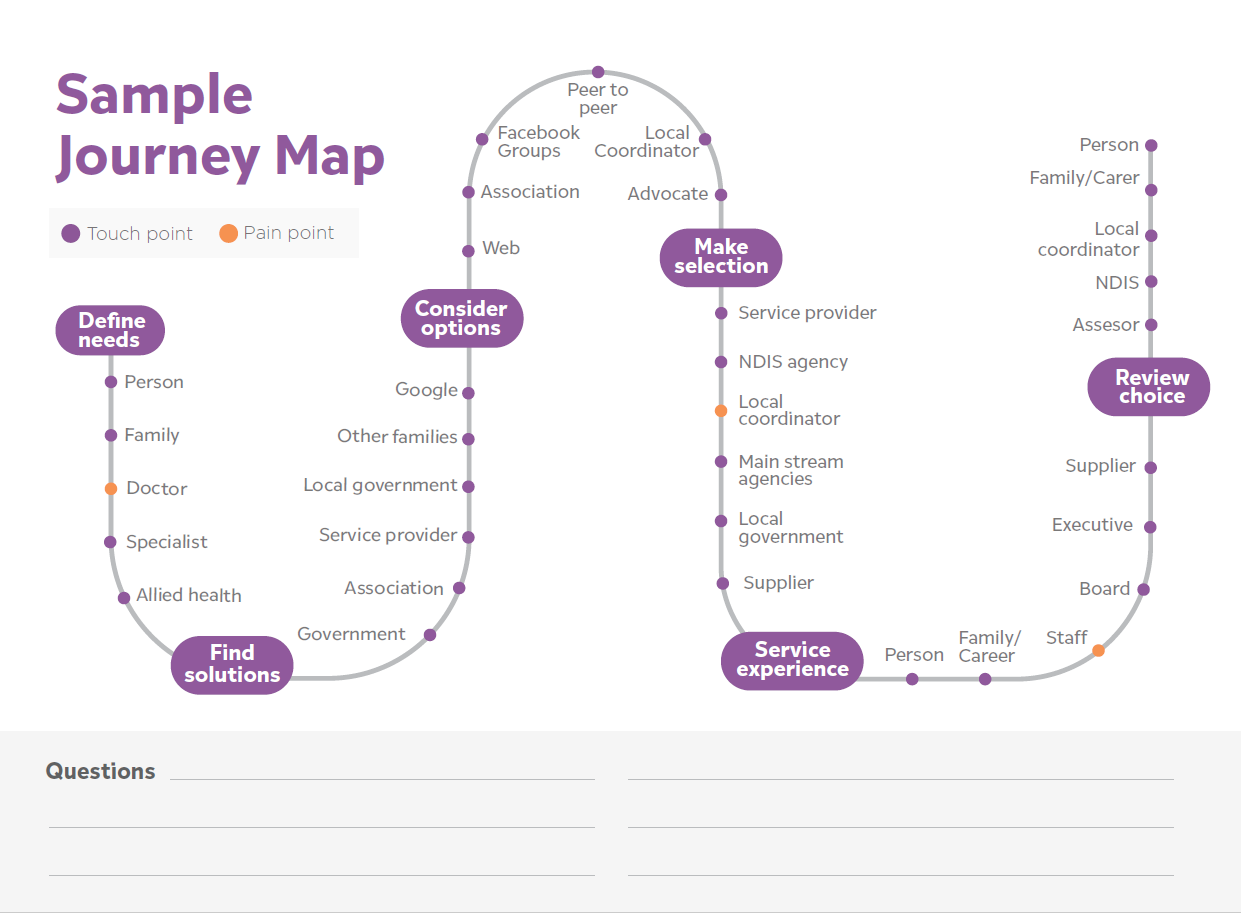
Assumption Busting
Please follow these steps to use the Assumption Busting Tool:
- Identify the assumption you need to challenge. Ask the person or group questions about what is known, to identify what is driving any assumptions.
- Use reframing to find ways to resolve the issue which lies beneath the assumption.
- It’s a useful tool if your thinking gets stuck or you run out of ideas.
- It challenges set thinking and allows users to be more creative in their problem solving.
Exercise: Assumption busting
- What are assumptions?
- How do we reframe the thinking?
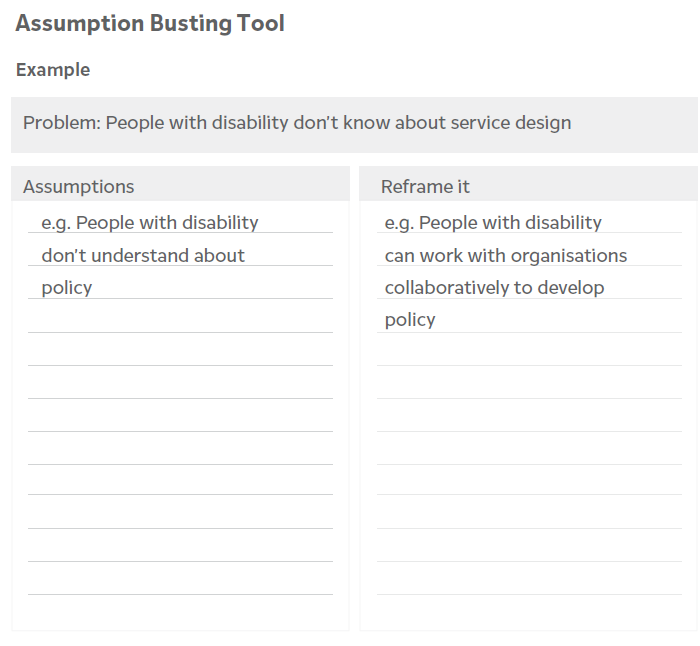
Develop
About Develop
Working with People with Disabilities to turn ideas into improvements that will lead to better experiences.
Stakeholder Needs Comparison
- A Stakeholder is anyone that is affected by an organisation, project or process
- A Stakeholder Needs Comparison table shows everyone's different needs. Comparing each other’s needs can help identify common goals and ideas or possible improvements that can help more than one stakeholder.
- Use it to compare needs: for example the needs of a person with disability compared to a manager or support staff needs.
- Use a large whiteboard or sheet of paper and list issues for people with disability across the top. Then list the needs of services providers (or other stakeholders) down the side.
- Work across and down the table, put a tick in each box where the needs clearly match. Then number each tick.

Improvements and Benefits
- Use the improvements and benefit template to brainstorm specific improvements from perspectives of both people with disability, service providers (or other stakeholders), writing benefits for each alongside.
- You may notice patterns in the types of improvements being suggested. Review these and look for improvements that address multiple issues and/or achieve benefits for multiple stakeholders. These are likely to be the highest-value improvements and the most important to focus on.

Decide
About Decide
Choosing what improvements to make and how to make them. Success depends on understanding the requirements of people with disability and their insights about service improvements.
Platforms
This refers to social media platforms and other online spaces that are used to engage with consumers to improve products and services.
Different people use online media differently and it can be used to target people based on who they are, where they are and how they live.
It can be a way of sharing options that have been developed to bring people together in a collaborative decision making process
Commonly used online platforms include Facebook and Twitter. Facebook can be used to share information, gather feedback and make decisions. This might be done on a public page or in a closed group that has been set up for invited participants to address a specific issue. Twitter can be used to ask open ended questions or conduct brief surveys. Other examples include Loomio and Doodle polls, where decisions can be made without meetings.
There are regular reports about social media use available online that can help you decide which social media channel best suits your purpose.
Organisations that undertake co-design may develop a dedicated website or webpage that is used routinely to engage with a target audience.
- Loomio (www.loomio.org) is an app that helps people make decisions together. It helps collaborative decision making through increasing accesibility and diversity.
- The Lego Ideas website (ideas.lego.com) supports a community of Lego enthusiasts. Lego fans can post ideas for new Lego products, give feedback on other people’s ideas and help the company decide which ideas should be developed into actual products.
Change
About Change
This step records evidence of the difference an improvement has made to the experience, what the change is, which part of the service made the change and the evidence of the difference and improvement has made to the experience of people with disability.
This tool focuses on the person’s experience and explores improvements without needing a lot of detail about the current experience, by comparing and contrasting new experiences with the current.
The Biggest Difference Tool
You can use this tool to evaluate a prototype or pilot version of an improvement, or to monitor the performance of an improvement after implementation.
The Biggest Difference Template
Please follow these steps to fill the Biggest Difference template:
- Identify the key users of the improvement and make sure you have identified the types of person with disability the improvement is designed for.
- Make sure you check the improvement works equally well for different people. Assess whether it is working best for those who need it most (without compromising the service for others).
- Get people with disability to trial it during actual service delivery and observe people having the experience.
- Ask the person to tell you about their experience of the improvement. Use open-ended, non-specific questions. Video is a very useful way of capturing critical aspects of the person's experience.
- Work through the questions to help the person to evaluate the improvement. Make sure the person has time to reflect on the questions and answer them fully. Some paraphrasing and encouragement should be used.
- Document your findings about the experiences carefully. Use the Biggest Difference template to help you do this.
- Identify changes to improve experience. Review your findings. Identify ways to reduce negative effects and maximise the benefits of the improvement.
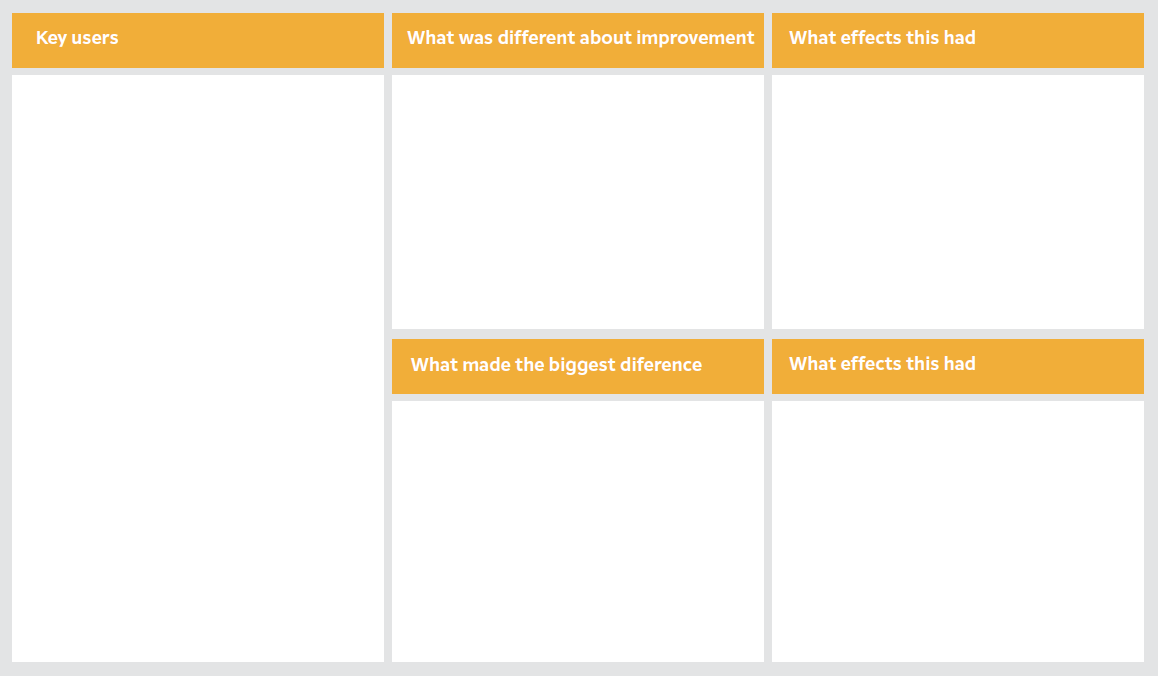 Sample Questions
Sample Questions
- How has this improvement made a difference to you? Was anything else different? [Repeat until they say ‘no’.]
- What was the biggest difference the improvement made for you?
- How did the changes affect you while you were accessing the service, at home or during other times?
- What effects, good and bad, did [name one difference they mentioned] have for you? [Repeat until all differences have been checked.]
- What effects, good and bad, did this biggest difference have for you?
- What ideas and suggestions do you have about making this difference even bigger and better for you?
Service Blueprints
A simple blue print records the steps within a business process or service. It documents what happens during the interaction between the customer and the organisation and what happens behind the scenes. It records customer actions and the organisations response. It also documents the business activity needed to support the interaction and the business systems/or processes required.
Each customer action is listed separately and occurs over an expected time frame.
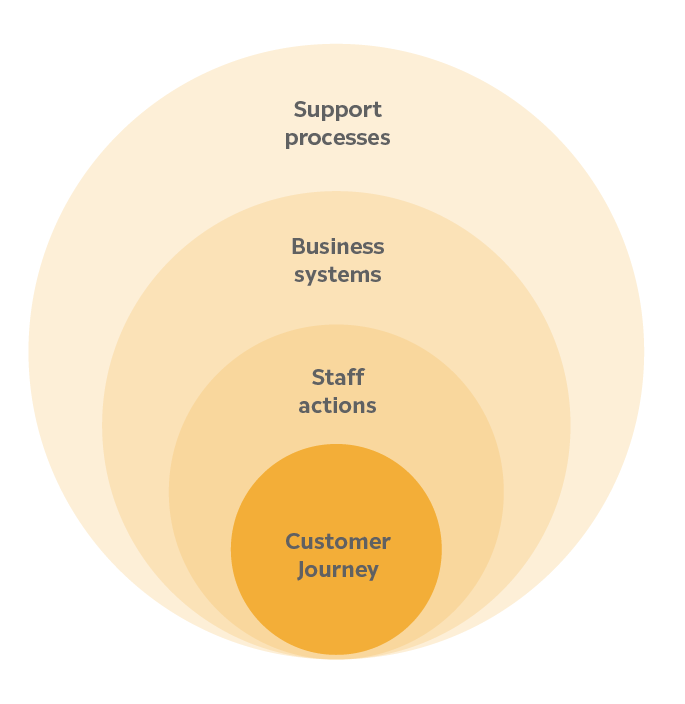
Example: using an Expression of Interest (EOI) process
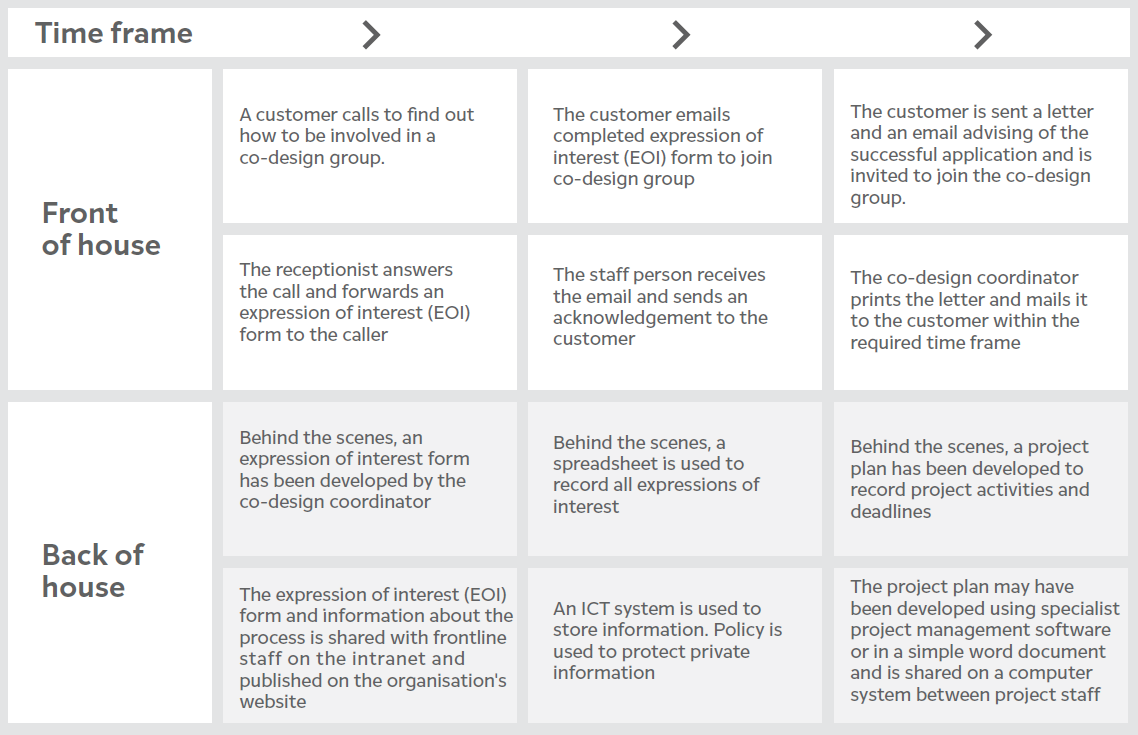
Co-Design Principles
Principles to follow
- Engage people with disability and encourage involvement in the process from the very beginning and throughout the whole journey.
- Ensure everyone understands the common goal.
- Be prepared to compromise
- Commit to working together in collaboration as a team.
- Make sure the process includes mutual exchange and is more than consultation.
- Use a listening approach and be empathetic, flexible and supportive.
- Be professional and respectful.
- Look for solutions that are functional, useable and sustainable.
Appendix
Quick Links
- Disability Discrimination Act 1992
- Convention on the Rights of Persons with Disabilities
- National Disability Strategy 2010-2020
- National Standards for Disability Services
- UN Declaration on rights of Indigenous Peoples
- Disability (Access to premises – building) Standards 2010
- Occupational Safety and Health Act 1984
- Equal Opportunity Act 1984
Acknowledgements
PWdWA Inc. would like to acknowledge the following people and organisations:
- Co-design Steering Group:
Ben Sgherza
Evelyn McKay
Angelo Cianciosi
Elizabeth Edmondson
Nick Wilson
Joanne Pelham
Ming Luo
- Co-design Project Team:
Faye Hicks, PWdWA
Natalie Turner, PWdWA
Alison Blake, Strategic Support
- State Government through the Department of Finance
- Chorus
- City of Belmont
- WACOSS
PWdWA Inc. would like to acknowledge that this co-design guide was adapted from:
- Website www.healthcodesign.org.nz
Health Service Co-design: Working with patients to improve services,Hilary Boyd, Stephen McKernon and Andrew Old. Waitemata District Health Board: Auckland. 2010. - NDS Co-design for Community Inclusion by Cat Sutton-Long, Kristina Skov Aagaard, Dr Zaana Howard, Vito Tassone & Huddle
- MARCIA Project
- NDS National Standards for Disability Services tool kit
- WACOSS Co-design toolkit
Disclaimer
This Co-design training toolkit is made available by PWdWA for information purposes as well as to give you a general understanding of co-design with people with disability, not to provide specific advice on disability.
By using this Co-design training toolkit you understand that there is no relationship between you and PWdWA. This training toolkit does not bind PWdWA and does not create any rights or benefits that are enforceable by any party.
PWdWA does not make any warranties about the completeness, reliability and accuracy of this information. Any action you take upon the information is strictly at your own risk, PWdWA will not be liable for any losses and damages in connection with the use of our model.
This Co-design information is not for sale, to be sold, reproduced and/or modified, unless prior permission is received in writing from PWdWA.
References
- WACOSS Tool Kit
www.wacoss.org.au/wp-content/uploads/2017/07/co-design-toolkit-combined-2-1.pdf - Health services NZ
www.healthcodesign.org.nz/tools/TOOLKIT_WEB_DOWNLOAD.pdf - National Standards for Disability Services
www.dss.gov.au/sites/default/files/documents/12_2013/nsds_web.pdf - MARCIA Project
www.bunbury.wa.gov.au/Pages/MARCIA.aspx - Alison Blake - Strategic Support
www.strategicsupport.com.au
